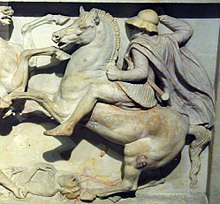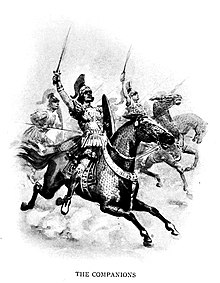Companion cavalry
This article has multiple issues. Please help improve it or discuss these issues on the talk page. (Learn how and when to remove these messages)
|

The Companions (Greek: ἑταῖροι, Greek: [heˈtairoi̯], hetairoi) were the elite cavalry of the Macedonian army from the time of King Philip II of Macedon, achieving their greatest prestige under Alexander the Great, and regarded as the first or among the first shock cavalry used in Europe.[1] Chosen Companions, or Hetairoi, formed the elite guard of the king (Somatophylakes).
Etymology
[edit]The name of the military unit derives from Greek Hetairoi, those near the king. The Hetairoi (Companions) could be members of the Macedonian aristocracy or commoners of any origin who enjoyed the trust and friendship of the Macedonian regent. The Hetairideia, a festival pertaining to the sacred relationship which bound the king and his companions together[2] was celebrated and even Euripides, the famed Athenian playwright, was honoured as an hetairos of the king Archelaus.[3] The Royal friends (Philoi) or the king's Companions (basilikoi hetairoi) were named for life by the king among the Macedonian aristocracy.
Unit
[edit]Equipment
[edit]
Companion cavalry would ride the best horses, and receive the best weaponry available. In Alexander's day, each carried a xyston (long thrusting spear), and wore a bronze muscle cuirass or linothorax, shoulder guards and Boeotian helmets, but bore no shield.[4] A kopis (curved slashing sword) or xiphos (cut and thrust sword) was also carried for close combat, should the xyston be lost or broken.
Organization
[edit]The Companion cavalry was composed of the Hetairoi of the king, mainly upper class citizens who were able to acquire and maintain armour and horses. In the age of Philip II and Alexander they were organized into 8 territorial squadrons, termed ilai. Each ile numbered between 200 and 300 horsemen.[5][6] They were originally commanded by a single leader, Philotas under Alexander the Great, but following his execution would see the leadership split between two men, Cleitus the Black and Hephaestion.[7][8] Arrian claims this would be because, Alexander "did not want anyone, not even his intimate friend, to be the centre of attention".[9] After receiving reinforcements in Susa, Alexander established two companies in each squadron.[10] They were referred to by the name of the territory they were mustered in or by the name of its captain. The Royal Ile was commanded by Alexander himself and contained twice the number of soldiers the other units contained, c. 400.[6] These cavalry squadrons would sometimes be combined in groups of two, three or four to form a hipparchy, which was commanded by a hipparch, though the whole Companion force was generally commanded by Alexander.[6]
In Alexander's Balkan campaigns, we find mention of Companions from upper Macedonia, the central Macedonian plain and Amphipolis.[11][12] During the advance on Granicus, a squadron commanded by Socrates of Macedon (not to be confused with the philosopher) hailed from Apollonia on Lake Bolbe.[12] During the Battle of Issus, Arrian names the ile of Anthemus (modern Galatista),;[11] another, from the unidentified land of Leuge (likely Pieria), is also mentioned.[13]
Theopompus describes the Companions, probably of around the mid 4th century BC, as being made of "no more than 800 at this time" and mustered "some from Macedonia, some from Thessaly and still others from the rest of Greece".[14] By 338 BC, Alexander is reported to have had around 2600 in his Companion Cavalry.[15] As Alexander's force campaigned towards India, barbarians played an increasing role in the Companion Cavalry and the Macedonian mutiny at Opis may have been partially caused by this.[16][17] At one point, there were four hipparchies made up of entirely oriental forces and one that was a mix of Macedonians and orientals.[16]
Tactics and use
[edit]
The Companions constituted one of the first shock cavalry in history, able to conduct charges against massed infantry. Many contemporary cavalry, even when heavily armored, would most usually be equipped with javelins and would avoid melee[citation needed]. In this respect, Companions were similar to the older Iranian heavy cavalry who were armed with lances and also engaged in melee combat.
In battle, it would form part of a hammer and anvil tactic: the Companion cavalry would be used as a hammer, in conjunction with the Macedonian phalanx-based infantry, which acted as their anvil. The phalanx would pin the enemy in place, while the Companion cavalry would attack the enemy on the flank or from behind.
In battle, Alexander the Great personally led the charge at the head of the royal squadron of the Companion cavalry, usually in a wedge formation. In a pitched battle, the Companions usually fought on the right wing of the Macedonian army, next to the shield-bearing guards, the hypaspists, who would guard the right flank of the phalanx. Other cavalry troops would protect the flanks of the Macedonian line during battle. Under Alexander's command, the Companions' role was decisive in most of his battles in Asia[citation needed].
Legacy
[edit]Hellenistic kingdoms
[edit]
The Companion cavalry of the Diadochoi (Alexandrian successor-states), were even more heavily equipped. Seleucid Companions were noted to have worn lighter, but not otherwise dissimilar, equipment to the cataphracts at the Battle of Magnesia in 190 BC, which may have included partial horse armour and leg and arm protection. Ptolemaic Companions and Antigonid Companions were also equipped with a large round aspis cavalry shield unlike the Companions of Phillip and Alexander.
'Companions' was a title not used by the Seleucids in its original sense. It was replaced with different and various grades of 'King's Friends'. However, the title 'Companions' was kept as a regimental one. There was only one regiment or unit that held the title of Companions in the entire Hellenistic world though; the Antigonids and Ptolemies had different names for their elite cavalry regiments.
Eastern Roman Empire
[edit]The Hetaireia or Hetaeria was a corps of bodyguards during the Byzantine Empire. Its name means "the Company", echoing the ancient Macedonian Companion cavalry. The imperial Hetaireia was composed chiefly of foreigners. They acted as part of the Byzantine imperial guard alongside the tagmata in the 9th–12th centuries.
See also
[edit]- Hetair-, a Greek linguistic root
- Hetaireia
- Panegorus
- Pezhetairos
- Sarissophoroi
- Somatophylakes
References
[edit]- ^ Hanson, Victor Davis (2007-12-18). Carnage and Culture: Landmark Battles in the Rise to Western Power. Knopf Doubleday Publishing Group. ISBN 978-0-307-42518-8.
- ^ Winthrop Lindsay Adams. Alexander the Great: legacy of a conqueror. p 8. ISBN 0-321-08617-1. (2004)
- ^ John V. A. Fine. The ancient Greeks: a critical history. p 612. ISBN 0-674-03314-0. (1983)
- ^ Lonsdale 40
- ^ Fuller 49
- ^ a b c Lansdale 41
- ^ SÁNCHEZ, JUAN PABLO (2018-09-27). "How suspicion and intrigue eroded Alexander's empire". National Geographic. Archived from the original on December 14, 2019. Retrieved 2020-08-28.
- ^ Grote, George (1907). A History of Greece: From the Earliest Period to the Close of the Generation Contemporary with Alexander the Great. John Murray.
- ^ Sage 185
- ^ Arrian, Alexander's Anabasis, III.16
- ^ a b Hammond 414
- ^ a b Hammond 416
- ^ Hammond 415
- ^ Sage 173–174
- ^ Sage 174
- ^ a b Lansdale 56
- ^ Arrian, Alexander's Anabasis VII.6
Works cited
[edit]- Fuller, John Fredrick Charles (2004). The Generalship of Alexander the Great. Da Carpo Press. ISBN 978-0-306-81330-6. can be found at Google Books in preview
- Hammond, Nicholas G. L. (1998). "Cavalry Recruited in Macedonia down to 322 BC". Historia: Zeitschrift für Alte Geschichte. 47 (4): 404–425. JSTOR 4436520.
- Lonsdale, David J. (2007). Alexander the Great:lessons in strategy. Routlidge. ISBN 978-0-415-35847-7. can be found at Google Books in preview
- Sage, Michael M. (1996). Warfare in ancient Greece. Routlidge. ISBN 978-0-415-14355-4. can be found at Google Books in preview
Lua error in Module:Navbox at line 192: attempt to concatenate field 'argHash' (a nil value).
